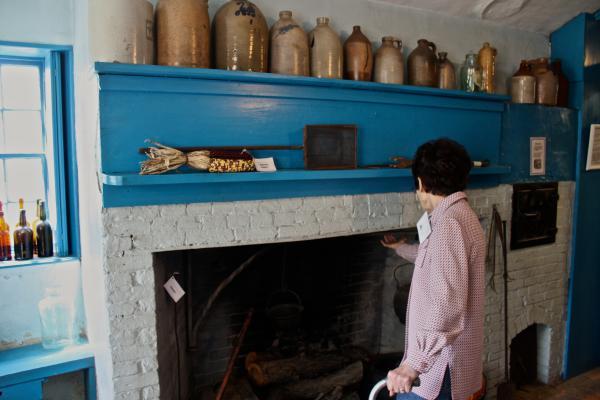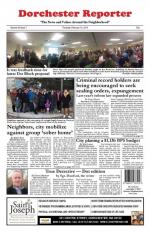May 30, 2014

A visitor inspects the basement kitchen of the William Clapp House on Boston Street. Photo by Lily Bouvier
Visitors to the Dorchester Historical Society were given free rein to explore the nooks and crannies of some of Dorchester’s first houses at the Society’s “Behind the Scenes” event on May 18. All of the homes and buildings belonging to the Society were open, from basement to attic, 11 a.m.-4 p.m., with visitors invited to wander at their own pace from room to room.
Although the Dorchester Historical Society opens its doors to the public on the third Sunday of every month, the event on this particular Sunday was unique: Visitors were allowed not just into exhibit rooms, but also into rooms that house the day-to-day operations of the museum.
Members of the Historical Society were situated in each area to offer individualized tours, insight, and conversation all along the way. Visitor Jan Gable, of South Boston, said she was impressed by the wealth of information each of the Society’s members offered.
“They’re so knowledgeable,” she said, as she left from her visit to the museum Sunday.
Jennifer Paulsen and her husband Joe Bagley, who serve as caretakers for the Society’s William Clapp House—the pink one with its front doors at 195 Boston Street—were both at the home for the event, eager to introduce visitors to the piece of Dorchester history that they love and care for.
In the Clapp House attic, Bagley showed visitors old graffiti etched into attic beams—details that, as he put it, show that the space “has so much time.”
“Sometimes you go into a house museum and it’s so sterile,” Bagley remarked.
The event on Sunday, though, was anything but: In rooms usually off-limits to visitors, the TVs, lamps, couches, and other modern home furnishings belonging to the homes’ caretakers presented an amusing contrast to the wood-burning hearths and bread ovens belonging to the farm families who once inhabited the homes. Stacks of archival boxes in the basements stood in stark juxtaposition to the structures’ wooden beams cut from trees dating back to the fifteenth century.
The experience offered visitors a glimpse at the radical change that Dorchester has undergone over the course of the centuries since it was first settled by English immigrants in 1630. From the attic of the Clapp house, Bagley said he likes to imagine those changes by peering out at the views below.
“That used to be an orchard,” he said, pointing out at the busy stream of honking cars on Boston Street below. Someone who once looked out of those windows, he said, instead of seeing the South Bay Shopping Plaza or the parking lot housing Verizon telephone repair vehicles, might see a view of Dorchester Bay, or the fields of pears, apples, berries, and hay that once grew all around.
A closer examination of street names in the area provides evidence. Harvest, Dorset, Washburn—all these are the names of types of apples and pears hybridized on the Clapp family farm, explained Paul DeLorey, Vice President of the Dorchester Historical Society, who meanwhile gave tours of the Clapp family barn next door to the house.
On display inside the barn were rows and rows of tools, once used to work the Dorchester land that now is paved by streets and sidewalks. As visitors came by, DeLorey recounted the structure’s recent renovation project: Nine years ago, the barn was full of leaks and near collapse. Possums, skunks, raccoons, and hedgehogs had all made their homes inside.
“The dust in here was that thick,” said DeLorey as he demonstrated a two-inch width with his thumb and forefinger. After extensive research, almost a decade of work, and $350,000 worth of construction, there are just three windows and two small doors left to repair.
Anya Weber, of Brookline, said her visit Sunday made her think about her own role in preserving history. The story of the newly restored barn, she said, reminded her of her own family’s farm in New York State. “It makes me think about—should we be preserving our farm house?” she said.
Preserving history, though, takes a lot of hard work and sweat. Back at the Clapp House, constant upkeep is required: Paulsen and Bagley are responsible for keeping all the rooms of the house in good repair, as well as for landscaping the acre of land that surrounds it. In preparation for Sunday’s visitors, Bagley said the two cleaned for ten hours the day before.
Even so, Bagley was excited to open up so much new space to visitors on Sunday, and he said he hopes the Historical Society will hold another “Behind the Scenes” event again in the future.
Just, he added with a smile, “hopefully not every month.”
Topics:



